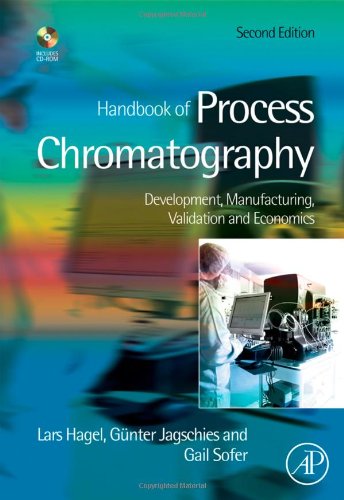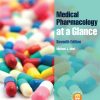Handbook of Process Chromatography 2nd Edition by Lars Hagel, Günter Jagschies, Gail Sofer ISBN 9780080554518 0080554512
$50.00 Original price was: $50.00.$35.00Current price is: $35.00.
Handbook of Process Chromatography 2nd Edition by Lars Hagel, Günter Jagschies, Gail Sofer – Ebook PDF Instant Download/Delivery: 9780080554518 ,0080554512
Full download Handbook of Process Chromatography 2nd Edition after payment

Product details:
ISBN 10: 0080554512
ISBN 13: 9780080554518
Author: Lars Hagel, Günter Jagschies, Gail Sofer
This book will update the original edition published in 1997. Since the publication of the first edition, the biotechnology and biologics industries have gained extensive knowledge and experience in downstream processing using chromatography and other technologies associated with recovery and purification unit operations. This book will tie that experience together for the next generation of readers.
Updates include:
– sources and productivity
– types of products made today
– experiences in clinical and licensed products
– economics
– current status of validation
– illustrations and tables
– automated column packing
– automated systems
New topics include:
– the use of disposables
– multiproduct versus dedicated production
– design principles for chromatography media and filters
– ultrafiltration principles and optimization
– risk assessments
– characterization studies
– design space
– platform technologies
– process analytical technologies (PATs)
– biogenerics
– comparability assessments
Key Features:
– new approaches to process optimiaztion
– use of patform technologies
– applying risk assessment to process design
Handbook of Process Chromatography 2nd Edition Table of contents:
Chapter 1. Biopharmaceuticals Today
1.1 Industrial Context
1.2 Overview of Biopharmaceutical History
1.3 Biopharma Business Environment
1.4 Key Business Issues
1.5 Process Chromatography Within an Industrial Context
1.6 Summary
References
Chapter 2. Process Capability and Production Scenarios
2.1 Process Capability
2.2 Production Setups
2.3 Process Capability Conclusions
References
Chapter 3. Process-Design Concepts
3.1 Typical Process Design for Biopharmaceuticals
3.2 Management Framework for Process Design
3.3 Production Cells and Typical Product Characteristics
3.4 Risk Analysis and Risk Mitigation
3.5 Downstream Processing
3.6 Selected Downstream Processing Platform Examples
3.7 Characterizing the Process, Process Understanding
References
Chapter 4. Separation Technologies
4.1 Introduction
4.2 Recovery
4.3 Purification
4.4 Equipment
4.5 Selecting Tools from R&D to Production
References
Chapter 5. Analysis
5.1 Introduction
5.2 Proteins
5.3 Nucleic Acid Products
5.4 Comparability
5.5 Setting Specifications and Reference Standards
5.6 Method Validation
5.7 Process Analytical Technologies (PAT)
References
Chapter 6. Cleaning and Sanitization
6.1 Introduction
6.2 Cleaning
6.3 Decontamination of Transmissible Spongiform Encephalopathy Agents
6.4 Sanitization
References
Chapter 7. Validation
7.1 Introduction
7.2 What to do When?
7.3 Validation of Downstream Processes
7.4 Making Changes
7.5 Summary
Acknowledgements
References
Chapter 8. Economics
8.1 Economics: An Educational Excursion
8.2 LEAN Manufacturing, Removal of Unproductive Activities
8.3 Cost Model: Monoclonal Antibody Downstream Process
8.4 Cost Improvement Options
8.5 Impact from R&D, Platform Strategies and Technology Outlook
8.6 Conclusions, the Improvement Hierarchy
References
Chapter 9. Basic Properties of Peptides, Proteins, Nucleic Acids and Virus Particles
9.1 Introduction
9.2 Peptides
9.3 Proteins
9.4 Nucleic Acids
9.5 Viruses
References
Chapter 10. Optimization of Chromatographic Separations
10.1 Introduction
10.2 Basic Relationships
10.3 Purification Principles
10.4 Adsorption
10.5 Elution Modes
10.6 Bed Configuration
10.7 Experimental Determination of Basic Parameters
10.8 Modelling of Chromatographic Purifications
10.9 Simulation of Separations
References
Chapter 11. Equipment
11.1 Guidelines for Selecting Pilot Plant and Production Chromatography Equipment
11.2 Selection of Components
11.3. Automation
References
Chapter 12. Column Packing
12.1 Introduction
12.2 Theory
12.3 Preparation of Column and System
12.4 Packing the Column
12.5 Evaluating Column Packing Quality
12.6 Scale up
References
Appendix A: Symbols and Definitions in Liquid Chromatography
A.1 Introduction
A.2 Symbols Used in Liquid Chromatography
A.3 Definitions of Chromatographic Parameters and Equations
References
Appendix B: Dimensionless Numbers
B.1 Introduction
References
Appendix C: Activities for Biopharmaceutical Production from Genetically Engineered Mammalian Cells
C.1 Introduction
C.2 Activities Chart from Toxicology to License Application
Appendix D: Simulations Using the Supplied Software
D.1 Introduction
D.2 How to Use the Software?
D.3 Pressure Drop
D.4 Sample Volume
D.5 Resolution in SEC
D.6 Resolution in IEC, RPC and HIC
D.7 Isocratic Separation
D.8 Yield and Purity
D.9 Langmuir Isotherm
D.10 About this Software
Subject Index
People also search for Handbook of Process Chromatography 2nd Edition:
handbook of process chromatography pdf
handbook of ion chromatography
handbook of analytical validation
introduction to chromatography pogil answer key
Tags:
Lars Hagel,Günter Jagschies,Gail Sofer,Process Chromatography



